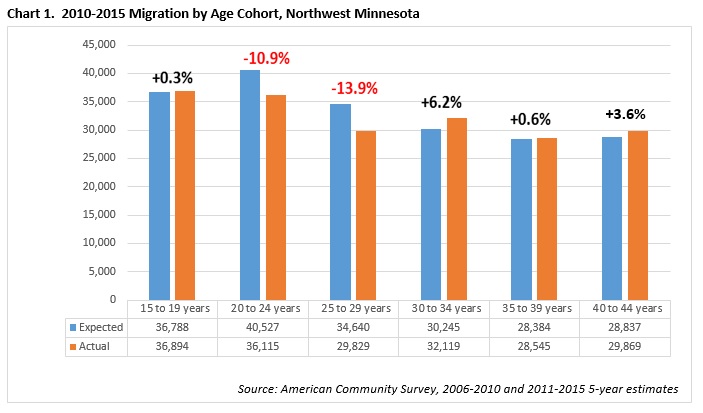 The presence of such industry powerhouses as Polaris, Arctic Cat and New Flyer make Northwest Minnesota a hub of transportation equipment manufacturing.
The presence of such industry powerhouses as Polaris, Arctic Cat and New Flyer make Northwest Minnesota a hub of transportation equipment manufacturing.
From wheat and potatoes to soybeans and sugar beets, the region is a major producer and processor of food staples and specialty agricultural products.
Want the freshest data delivered by email? Subscribe to our regional newsletters.
12/13/2016 12:04:56 PM
Chet Bodin
Discussion surrounding the millennial generation is widespread and multi-faceted, largely because they are set to make up the largest segment of the workforce in Minnesota and the nation in the next decade. But what makes millennial impact even more important to employers, policy-makers, and educational institutions is the context of their arrival. Even as millennials enter the labor force in droves, baby boomers are exiting even faster. Not only are values and norms in the workplace changing, but the ensuing workforce shortage has created a simultaneous challenge.
In Minnesota the supply of millennial workers varies by region, and whether an employer is looking to attract more or live without them, their relative size in the workforce and migration patterns matter. These sizable demographic shifts are leading employers to examine generational context in their management and hiring strategies.
Generational identity is often based more on social acceptance than definite timelines, and specific boundaries of the millennial generation remain unsettled. If for no other reason, demographic starting and ending points need to be established to provide macro-level statistical analysis. Most efforts to pin down the boundaries of the millennial generation range between 1977 and 2002, where both the floor and ceiling vary.
The generational boundaries used here are set parallel to the data sources used for analysis. In 2015 estimates from the American Community Survey, millennials would have been between the ages of 13 and 38 at the widest range. ACS population estimates, however, are organized by five-year age groups (i.e. 0-4 years, 5-9 years, etc.) and trend analysis benefits from age ranges that follow suit. The youngest age limit can easily be increased to 15 since most people do not enter the workforce until at least that age anyway. In addition, most estimates of the millennial generation do not exceed 20 years in length, which would put the upper age limit at 34 years of age in 2015. By that estimation, millennials researched here would have been born from 1981 to 2000.
Based on this, the millennial generation – people between 15 and 34 years of age in 2015 – accounted for almost a quarter of the regional population in Northwest Minnesota. However, population projections from the Minnesota State Demographer show that millennials will hold a shrinking share of the region’s population over the next two decades due to changing migration patterns (Table 1). Either way, millennials will still have a significant impact on regional culture, economic demand, and workforce supply.

Twenty-somethings often migrate away from rural areas like Northwest Minnesota for other education and career opportunities. A simplified cohort analysis helps show how age groups shift over time – people who were in the 15 to 19 year old age group in 2010 will be in the 20- to 24-year-old age group in 2015. If no one moves in and no one moves out, the count of people in that age group in 2010 would provide an “expected” count of people in the next age group in the next five-year time period. However, “actual” numbers are oftentimes different, showing in- or out-migration.
For example, a large portion of the millennial generation aged into their twenties from 2010 to 2015, and over 8,000 more of these twenty-somethings vacated Northwest Minnesota than moved in (Chart 1). Based on the population projections in Table 1, it appears millennial out-migration will continue as those who are teenagers now graduate high school and begin to test other markets.

But Northwest Minnesota is a resilient region, whose rural qualities also attract a number of people, particularly those in their thirties and early forties. From 2010 to 2015, over 3,000 more persons aged 30 to 44 moved into Northwest Minnesota than moved out. Although that is less than the millennial out-migration, the potential for the gap to narrow will grow as millennials age. If millennials migrate to Northwest Minnesota more in their thirties and early forties like the generation before them just did, the relative density of millennials would give in-migration a bump, bolstering the regional population and workforce.
What’s the bottom line? While the Northwest Minnesota millennial population is likely to decline in the next decade, their impact in the regional workforce may still increase. As the entire generation comes of age, their labor force participation will increase, as will the proportion of millennials in the regional workforce, especially as baby boomers continue to exit (Table 2).

Fortunately, this gives employers time to prepare for an influx. If employers are ready to receive them, even more millennials might end up making Northwest Minnesota their home.
Contact Chet Bodin.